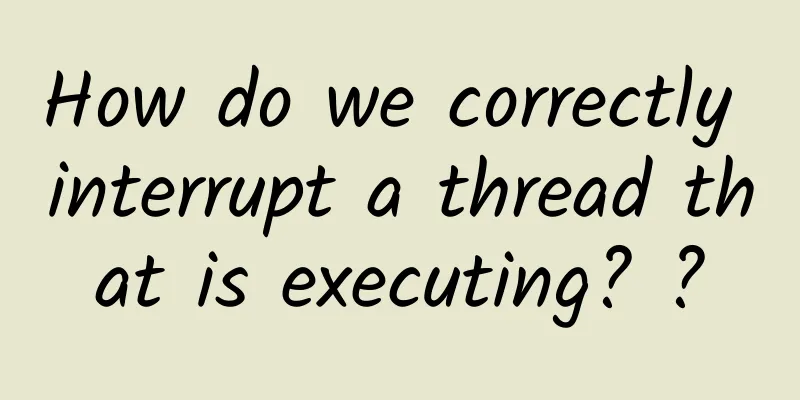How do we correctly interrupt a thread that is executing? ?

|
The author has developed a simple, stable, and scalable delayed message queue framework for high-concurrency scenarios. It has precise timed tasks and delayed queue processing functions. Since it was open sourced for more than half a year, it has successfully provided precise timed scheduling solutions for more than a dozen small and medium-sized enterprises and has withstood the test of production environments. In order to benefit more friends, the open source framework address is now provided: https://github.com/sunshinelyz/mykit-delay Preface When we call the wait() method of a Java object or the sleep() method of a thread, we need to catch and handle the InterruptedException. If we do not handle the InterruptedException properly, unexpected consequences will occur! Today, we will use a case to explain in detail why interrupting the execution of a thread does not work. Program Case For example, in the following program code, the InterruptedTask class implements the Runnable interface. In the run() method, the handle of the current thread is obtained, and in the while(true) loop, the isInterrupted() method is used to detect whether the current thread is interrupted. If the current thread is interrupted, the while(true) loop is exited. At the same time, in the while(true) loop, there is a line of Thread.sleep(100) code, and the InterruptedException is caught. The entire code is shown below.
The original intention of the above code is to check whether the thread is interrupted by the isInterrupted() method, and if it is interrupted, exit the while loop. Other threads interrupt the executing thread by calling the interrupt() method of the executing thread, which sets the interrupt flag of the executing thread, so that currentThread.isInterrupted() returns true, so that the while loop can be exited. This seems to be fine! But is it really so? We create an InterruptedTest class for testing, the code is as follows.
We run the main method as shown below. This is actually different from what we imagined! Different! Different! Why is this? Problem Analysis The above code clearly calls the interrupt() method of the thread to interrupt the thread, but it does not work. The reason is that when the run() method of the thread is executed, it is blocked on sleep(100) most of the time. When other threads interrupt the executing thread by calling the interrupt() method of the executing thread, it is likely to trigger InterruptedException. When the InterruptedException is triggered, the JVM will clear the interrupt flag of the thread at the same time. Therefore, the currentThread.isInterrupted() judged in the run() method will return false, and the current while loop will not be exited. Now that the problem has been analyzed clearly, how do we interrupt the thread and exit the program? Problem Solving The correct way to handle it should be to reset the interrupt flag after catching the exception in the while(true) loop in the run() method in the InterruptedTask class. Therefore, the correct code of the InterruptedTask class is as follows.
As you can see, we added a new line of code in the catch code block that captures the InterruptedException exception.
This allows us to reset the thread's interrupt flag after catching the InterruptedException, thereby interrupting the currently executing thread. We run the main method of the InterruptedTest class again as shown below. Summarize Be careful when handling InterruptedException. If an InterruptedException is thrown when the execution thread is interrupted by calling the interrupt() method of the execution thread, the JVM will clear the interrupt flag of the execution thread at the same time as the InterruptedException is triggered. At this time, calling the isInterrupted() method of the execution thread will return false. At this time, the correct way to handle it is to catch the InterruptedException in the run() method of the execution thread and reset the interrupt flag (that is, in the catch code block that catches the InterruptedException, call the interrupt() method of the current thread again). This article is reprinted from the WeChat public account "Glacier Technology". You can follow it through the QR code below. To reprint this article, please contact the Glacier Technology public account. |
<<: Software-defined home products improve remote productivity
>>: One million new 5G base stations will be built next year. Is that a lot?
Recommend
Development of Multi-core Fiber Connector Technology
Professor Ryo Nagase of Chiba Institute of Techno...
5G "new infrastructure", new scenarios, new models
Since the beginning of the year, the central gove...
Have you ever thought about why TCP needs to handshake before sending data?
When I look at computer networks, there is always...
8 ways businesses are using technology and tools for remote meetings
Participating in remote meetings can also be a pa...
A story about computer network concepts: gateway, DHCP, IP addressing, ARP spoofing, routing, DDOS, etc.
What is the role of a host computer gateway? Supp...
VIRPUS: 40% off on all VPS, Seattle data center, XEN architecture, monthly payment of $2, annual payment of $20
VIRPUS has released a December discount, offering...
Friendhosting New Year Sale 25% off all VPS/virtual hosts, VPS half-year payment starts from 12 euros
Friendhosting has launched a promotion titled New...
What is bandwidth management?
Bandwidth management involves the strategic alloc...
edgeNAT Hong Kong VPS host simple test
We have shared edgeNAT several times in the tribe...
Ten times faster than 5G? What is the future of 10G network?
In the digital age, how to use technology to prom...
Meet challenges and continue to innovate: Cisco Meraki opens a new hybrid office model
In the post-epidemic era, hybrid office has becom...
China’s 5G leads the world!
[[414223]] This article is reprinted from the WeC...
How will Yang Jie take the helm of China Mobile when the net profits of the two operators differ by 5 times?
It is not easy to "steer" China Mobile....
China Mobile: More than 560,000 5G base stations have been built
At the 2021 China Mobile Global Partner Conferenc...
In the new communications era, what opportunities and challenges does video compression technology face?
With the development of communication technology,...









